Automatic permafrost monitoring stations to cut risk of accidents in Arctic

YAKUTSK, August 7. /TASS/. The use of automatic permafrost monitoring stations will cut risks of accidents and will minimize possible financial losses from the thawing perennially frozen ground, said Yury Zakharinsky, an expert of the Siberian Federal University and the Academy of Sciences' Siberian Branch's Sukachev Institute of Forest.
Some 65% of Russia's territory is taken by perennially frozen grounds. The permafrost is changing with climate change. Its degradation disrupts technical systems in the Arctic, causes losses in hydrocarbon production and deformation of infrastructure facilities. This problem affects industrial and civil structures, roads, oil and gas pipelines, power lines, airport runways, equipment storages, fuel tanks, etc.
"Mere monitoring cannot make buildings and structures stable. Nor can it stop the destruction of roads, buildings, and berths. Therefore, we must urgently build up not only the domestic forecasting, but also a system to address negative processes that are increasingly taking place in the permafrost zone in the global climate change. <...> Automatic geocryology monitoring stations should appear 5-10 years prior to a potential construction or reconstruction of important facilities on permafrost soils. This is the only way to cut potential risks of man-made accidents and to minimize financial losses from design drawbacks," he told TASS.
The highest rates of annual temperature increase have been registered in the Arctic zone, he continued. Over half century, the average annual temperature in that region has increased by more than 3.6 degrees.
In 2021, Norilsk launched a geo-technical monitoring system and a center to monitor buildings and structures of Nornickel's Polar Division, he said. "The automatic geo-technical monitoring system has significantly increased the efficiency of monitoring buildings and structures without additional personnel. The monitoring system has been also implemented at the construction stage. This way, reinforcement sensors are installed inside the building structures."
Adaptation to permafrost
The scientist referred to thermal stabilization as an effective measure to adapt to the permafrost. This is a method to re-freeze soils and keep them in the frozen state. This work is underway in the Krasnoyarsk Region.
According to the region's Ministry of Industry, Energy and Housing, from the time the temperature stabilization systems were launched in December 2019 and through to March 2023, specialists reported a steady trend towards freezing of a significant ground mass of thawed soils under residential buildings. "High-temperature frozen soils have progressed into stable frozen solid conditions, and this was confirmed by measurements taken in temperature wells," the expert said.
The scientist pointed to a necessary complex of works to cut the cost of soil thermal stabilization systems. He insisted on the important aspect of federal subsidies for soil thermal stabilization in the Russian Federation's Arctic zone.
"The thermal stabilization of soils as an option to preserve foundations is cheaper than to build new houses: the cost of new construction in Norilsk is 276,200 rubles ($2,900) per sq. m, while the thermal stabilization cost is 18,000 rubles ($186) per sq. m of housing. It is 15 times cheaper than to build new housing," the expert noted.
Wind protection
According to the scientist, with bigger snowfalls, with remaining high average annual wind speeds, it is important to restore and continue the practice of dense blocks. "Experience of the kind was in Norilsk back in 1959: architects designed block Nr. 29, Zvenyagin Street. It was a closed-type block, and even arches leading inside the block had doors," he said.
Architecture of the kind reduced the wind speed, he continued. "That was fully successful. The wind speed there was 60% lower than elsewhere in the city, and this sufficiently increased the comfort."
Norilsk's housing stock consists of 860 apartment buildings, of which 240 are under special control due to conditions of soils and load-bearing structures. It is most important to use the existing foundation structures for further development of low-rise buildings as part of the program to renovate Norilsk's housing stock, the scientist added.
Damage from permafrost melting
Earlier, the Ministry for Development of the Far East and Arctic said the damage from the permafrost melting in the Russian Federation's Arctic zone could make 7 trillion rubles ($72 billion) by 2050. According to the ministry, the permafrost degradation accounts for 29% of losses in oil and gas production, problems with roads. Besides, most gas-bearing horizons are located in the Russian cryolithozone.
Photo by Gavriil Grigorov/TASS





